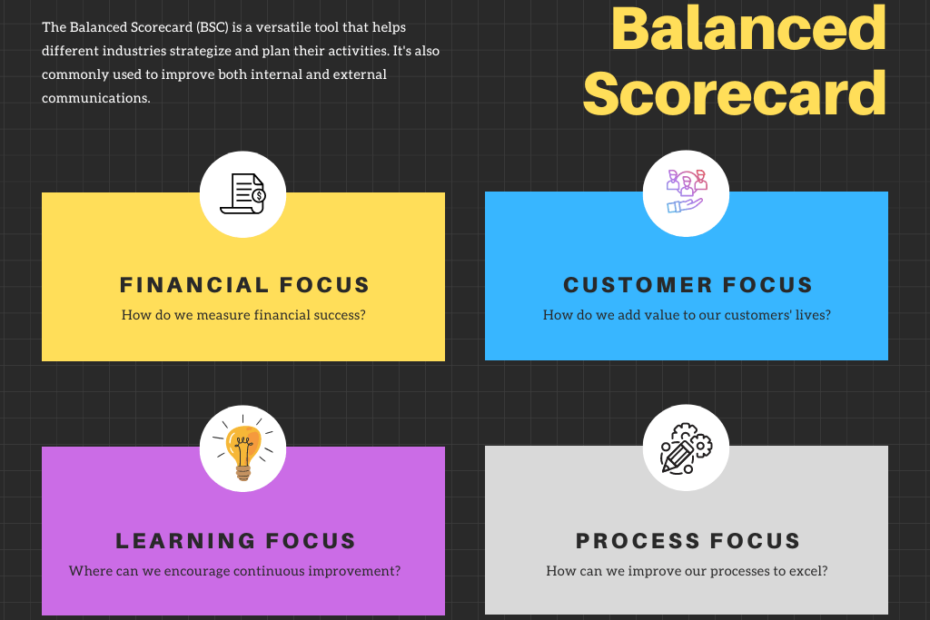The balanced scorecard (BSC) is a strategic management system that goes beyond traditional financial measures and incorporates four key perspectives for a more comprehensive view of business performance. Developed by Robert S. Kaplan and David P. Norton in 1992, the BSC is a superhero tool that enables organizations to translate their vision and strategy into actionable performance measures.
In this article, we’ll delve into the four perspectives of success and how the BSC can enhance your business performance. We’ll cover key components of the BSC, how to develop one for your organization, align it with your business strategy, and implement it for continuous improvement. We’ll also explore how to measure success with the BSC and provide real-life examples of successful implementation.
Introduction to Balanced Scorecard
First things first, let’s get visual. The Balanced Scorecard starts with a strategy map that’s like a treasure map leading you toward your goals. It’s a beautiful, colorful, and (dare I say it) fun way to visualize your strategic objectives and their interrelations.
Next up, we’ve got KPIs (that’s Key Performance Indicators for all you non-business lingo folks). You’re going to need to define and track these babies to measure your success, and as an Enterprise Architect, you’re the perfect person to work with key stakeholders to identify and define the KPIs that align with your organization’s objectives.
But it doesn’t stop there, my friends. The BCS also includes a performance management system to keep you on track and give you feedback on your progress. With your prowess as an Enterprise Architect, you can work with stakeholders to implement a system that tracks KPIs and provides regular feedback on your performance.
Lastly, let’s not forget the importance of aligning IT strategy with business strategy. The BSC framework emphasizes this point, and as an Enterprise Architect, you can ensure that your IT initiatives are designed to support the achievement of your strategic objectives. Trust me; you’ll be the MVP of the IT department.
Look no further than the Balanced Scorecard, your ultimate strategic management tool. As an Enterprise Architect, you have the power to wield it like a pro and achieve success.
Understanding the Four Perspectives of Success
Financial Perspective
Ah, the financial perspective – the bread and butter of the balanced scorecard. As an Enterprise Architect, you know how crucial it is to keep a close eye on the financial health of your organization. That’s why this perspective is all about those cold, hard numbers that keep the business world turning:
- revenue growth
- cost reduction
- profitability
- and the like.
Keep track of these measures, and you’ll ensure that your business stays afloat and on track for future success.
But don’t make the mistake of thinking that the financial perspective is the be-all and end-all of your performance management strategy. As important as it is, there are other perspectives that are just as vital to your organization’s success. By looking beyond the financials and considering the customer perspective, internal business processes, and learning and growth, you can gain a more well-rounded view of your performance and make better decisions for the long term.
Customer Perspective
The customer perspective is all about understanding your customers’ needs and preferences and ensuring that your organization is meeting or exceeding their expectations. This perspective focuses on the objectives and performance measures that are most relevant to your customers, such as
- customer satisfaction
- loyalty
- and market share.
To succeed in today’s competitive marketplace, it is crucial to have a deep understanding of your customers and their evolving needs. By focusing on the customer perspective, the balanced scorecard enables organizations to make more informed decisions about product development, marketing, and customer service strategies – ultimately driving customer satisfaction and long-term business success.
Internal Business Process Perspective
The internal business process perspective is all about ensuring that your organization is firing on all cylinders. By examining the efficiency and effectiveness of your organization’s value chain, you can identify areas of improvement and ensure that your organization is continuously enhancing its operational capabilities.
In this perspective, performance measures may include
- process efficiency
- cycle times
- defect rates
- and process innovation.
By tracking these measures, you can identify bottlenecks, streamline processes, and eliminate waste, ultimately leading to improved financial performance and customer satisfaction.
Learning and Growth Perspective
The fourth perspective of the balanced scorecard is the learning and growth perspective, which emphasizes the development of human, information, and organizational capital. In today’s fast-paced business environment, continuous learning and improvement are crucial for achieving long-term success.
To measure the performance of this perspective, organizations may track
- employee satisfaction
- employee turnover
- training and development programs
- knowledge sharing
- and innovation initiatives.
By monitoring these measures, enterprises can foster a culture of continuous learning and improvement that enables their employees to adapt to changing business conditions and acquire new skills and knowledge.
The learning and growth perspective recognizes that employees are the most valuable asset of an organization and that investing in their development is critical for driving innovation, improving operational efficiency, and achieving better financial performance.
By prioritizing this perspective, enterprises can create a sustainable competitive advantage that enables them to succeed in the long term.
The Importance of a Balanced Scorecard in Business Performance

By integrating the four perspectives of success, the balanced scorecard provides a holistic approach to performance management, enabling organizations to focus on key drivers of success and align resources with strategic objectives.
The balanced scorecard also allows organizations to monitor performance across multiple dimensions, beyond just financial results. By measuring and tracking customer satisfaction, internal processes, and learning and growth, organizations can gain a more comprehensive understanding of their performance and make informed decisions for long-term success.
Moreover, the BCS fosters a culture of continuous learning and improvement by emphasizing the development of human, information, and organizational capital. It also facilitates communication and collaboration across the organization, allowing for a more integrated and coordinated approach to achieving strategic goals
Key Components of a Balanced Scorecard
A well-designed balanced scorecard should include the following key components:
- Strategic objectives: These are the high-level goals that your organization aims to achieve. They should be aligned with your organization’s vision and strategy and should encompass all four perspectives of success.
- Performance measures (KPIs): For each strategic objective, you should identify one or more performance measures that will enable you to track your progress. These measures should be specific, measurable, achievable, relevant, and time-bound (SMART).
- Targets: For each performance measure, you should establish a target that represents the desired level of performance. Targets should be challenging yet achievable and should be aligned with your organization’s strategic objectives.
- Initiatives: These are the specific actions or projects that your organization will undertake to achieve its strategic objectives. Initiatives should be prioritized based on their potential impact on the organization’s performance and should be allocated appropriate resources and support.
- Responsibility: Each strategic objective, performance measure, target, and initiative should be assigned to a specific individual or team within your organization. This ensures accountability and helps to foster a sense of ownership among your employees.
By incorporating these key components, your balanced scorecard will provide a comprehensive framework for managing your organization’s performance and driving continuous improvement.
How to Develop a Balanced Scorecard for Your Business
Developing a balanced scorecard for your business involves the following steps:
- Define your strategic objectives: Begin by articulating your organization’s vision and strategy, and then identify the strategic objectives that will help you achieve these goals. Ensure that your objectives cover all four perspectives of success and are aligned with your organization’s overall strategy.
- Identify performance measures: For each strategic objective, identify the performance measures that will enable you to track your progress. Be sure to choose measures that are relevant, measurable, and actionable, and that provide a balanced view of your organization’s performance.
- Set targets: Establish targets for each performance measure, ensuring that they are challenging yet achievable, and aligned with your organization’s strategic objectives.
- Develop initiatives: Identify the specific actions or projects that your organization will undertake to achieve its strategic objectives, and prioritize them based on their potential impact on your organization’s performance.
- Assign responsibility: Assign responsibility for each strategic objective, performance measure, target, and initiative to a specific individual or team within your organization. This ensures accountability and helps to foster a sense of ownership among your employees.
- Communicate and cascade: Communicate your balanced scorecard throughout your organization, ensuring that all employees understand
Real-Life Examples of Successful Balanced Scorecard Implementation
When it comes to implementing a balanced scorecard, there’s no shortage of success stories. From large corporations to small businesses, organizations of all sizes and industries have leveraged the framework to achieve impressive results. Here are a few examples of successful implementation in action:
FMC Corporation
One well-known example is the implementation of the balanced scorecard at FMC Corporation, a global chemical manufacturing company. FMC’s balanced scorecard includes four perspectives: customer, internal processes, learning and growth, and financial.

FMC was able to reduce manufacturing cycle time by 50% and increase operating income by 40% in just three years.
North Shore-Long Island Jewish Health System
Another successful implementation can be seen at the North Shore-Long Island Jewish Health System, a large healthcare organization in New York.
By using the balanced scorecard to align its strategic objectives with its operational activities, North Shore-Long Island Jewish was able to improve patient satisfaction, reduce wait times, and achieve significant cost savings.

In just one year, the organization was able to save over $50 million in operating costs and improve patient satisfaction scores by 12%.
Canadian Pacific Railway
A third example of successful balanced scorecard implementation can be seen at Canadian Pacific Railway, a major transportation company. By aligning its strategic objectives with the framework, the company was able to improve operational efficiency, reduce costs, and improve customer satisfaction.

Canadian Pacific Railway was able to reduce fuel consumption by 2.5 million gallons and reduce the number of missed railcar connections by 30% in just two years.
These examples demonstrate the power of the balanced scorecard framework when it comes to achieving real-world results. By aligning strategic objectives with specific key performance indicators (KPIs) and targets, organizations can focus their efforts and resources on the activities that matter most for driving success.
Whether it’s improving operational efficiency, reducing costs, or increasing customer satisfaction, the BCF can help organizations achieve their goals and thrive in today’s competitive business environment.
Conclusion
In conclusion, the Balanced Scorecard is a powerful tool for organizations to improve their business performance and achieve long-term success. By aligning the four perspectives of success – financial, customer, internal business processes, and learning and growth – the Balanced Scorecard provides a comprehensive view of an organization’s performance. It enables organizations to
- focus on the key drivers of business success
- align resources with strategic objectives
- monitor performance across multiple dimensions
- foster a culture of continuous learning and improvement
- facilitate communication and collaboration
- and make more informed decisions for long-term success.
Implementing a Balanced Scorecard requires careful planning, clear communication, and a commitment to continuous improvement. Real-life examples have shown that the BCF can have a transformative impact on organizations of all sizes and industries. By integrating the framework into their strategic planning and performance management processes, organizations can navigate the complexities of today’s business environment, stay agile and responsive to changing market conditions, and achieve sustainable growth.
The Enterprise Architect’s Guide to Mastering Business Performance with the Balanced Scorecard can serve as a valuable resource for organizations looking to implement this powerful tool and take their performance to the next level.
